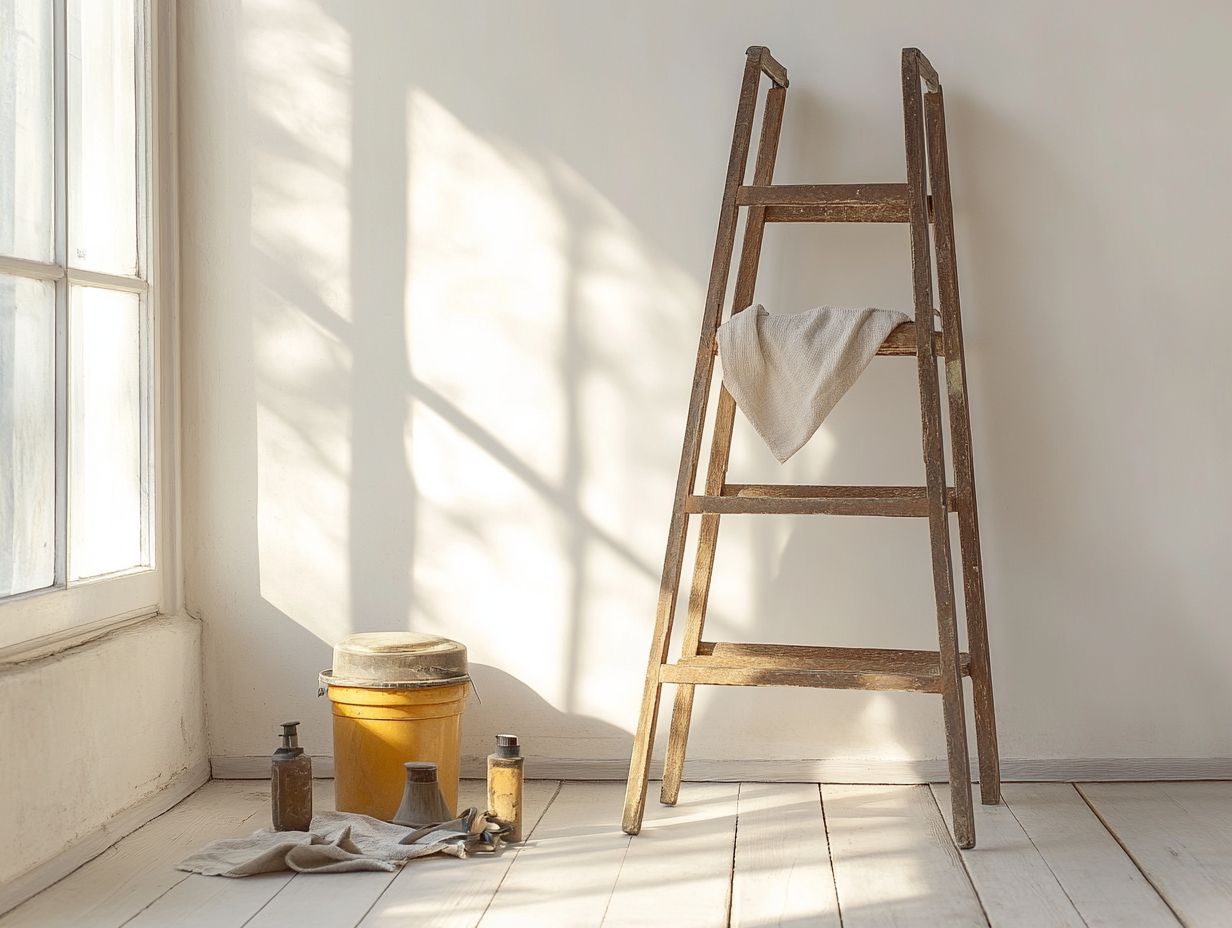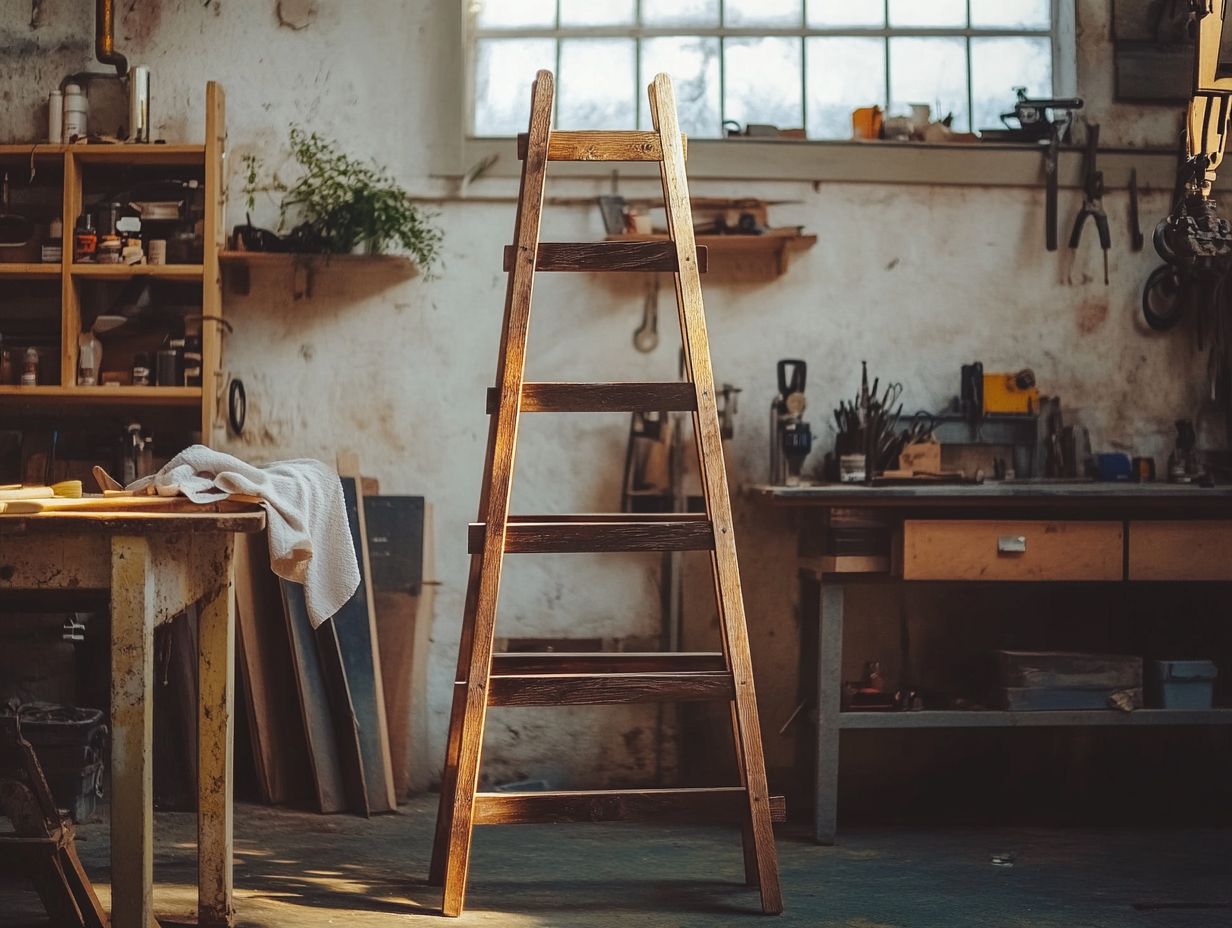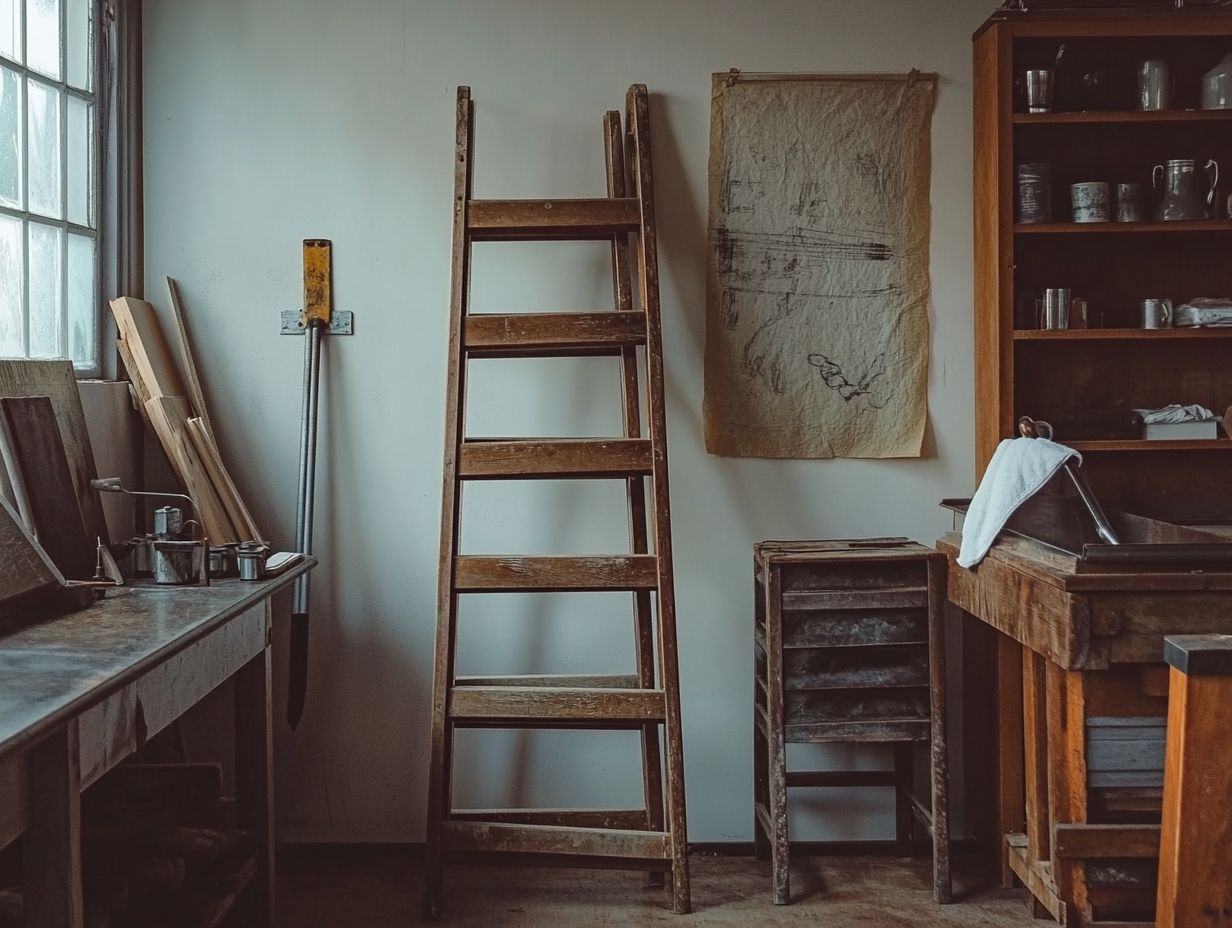Ladders are essential tools that serve as a critical link between safety and accessibility, whether one is a DIY enthusiast or a professional contractor.
Regular maintenance is vital to ensure that these tools remain safe and functional.
This article examines the significance of ladder upkeep, discussing the various types of ladders and their specific maintenance requirements.
Included is a comprehensive step-by-step guide for inspecting and repairing ladders, along with strategies to extend their lifespan and recommendations regarding when a replacement is necessary.
By understanding the importance of proper ladder maintenance, individuals can protect their investment and enhance safety.
The Importance of Ladder Maintenance

Ladder maintenance is essential for ensuring the safety, functionality, and longevity of various types of ladders, including wooden, aluminum, and fiberglass models. Conducting regular inspections and providing appropriate care can prevent accidents, extend the lifespan of the equipment, and uphold safety standards.
By adhering to manufacturer instructions and implementing a structured maintenance schedule, users can efficiently manage wear and tear, reduce corrosion, and enhance the durability of ladders, thereby ensuring reliable performance across various applications.
Furthermore, recognizing the importance of rust prevention and utilizing suitable cleaning solutions are critical components of equipment preservation that must not be overlooked.
Why Regular Maintenance is Essential
Regular maintenance of ladders is essential not only for ensuring safety but also for maintaining optimal functionality and performance over time.
A well-structured maintenance schedule is crucial for preserving the integrity of ladders. This involves conducting routine inspections to identify any signs of wear and tear, such as rust, rot, or material degradation that could compromise safety. Additionally, timely repairs should be scheduled to address potential issues before they develop into more significant problems. Utilizing an inspection checklist can facilitate thorough evaluations, ensuring that no critical components are overlooked.
By adhering to preventative maintenance practices, users can extend the lifespan of their equipment, enhance safety measures, and ultimately avoid costly repairs or accidents, thereby fostering a safer working environment for all.
Types of Ladders and Their Maintenance Needs
A comprehensive understanding of the various types of ladders—namely wood, aluminum, and fiberglass—is essential for determining their specific maintenance needs and requirements.
Each type of ladder possesses distinct characteristics that affect its durability, weight capacity, and performance under varying environmental conditions. For example, wood ladders may require regular inspections for wear and tear due to the risk of moisture damage, whereas aluminum and fiberglass models demand attention to corrosion resistance and appropriate cleaning methods.
By acknowledging these differences, users can develop customized maintenance strategies that enhance the longevity and reliability of their ladders.
Wooden Ladders

Wooden ladders, while traditionally esteemed for their strength and stability, necessitate specific care to ensure their longevity and safe usage. Regular inspections for signs of wear, such as splintering or warping, are essential. Additionally, routine cleaning is imperative to prevent the accumulation of dirt and moisture, which can accelerate deterioration. The use of protective gear and appropriate storage solutions is also critical in preserving the wood and enhancing its functionality. Recognizing the impact of environmental factors, such as humidity and temperature, enables users to implement effective preventive measures.
To maintain these essential tools properly, it is important to adopt a thorough cleaning technique. This includes utilizing a damp cloth combined with a mild detergent to remove accumulated grime, followed by a meticulous drying process to ensure no moisture remains trapped in the wood.
Furthermore, adequate storage solutions, such as maintaining ladders in a dry, shaded location and elevating them off damp surfaces, significantly reduce the risk of damage. Applying a high-quality wood preservative can also protect against rot and insect infestations, ultimately enhancing the functionality and reliability of the ladder during use.
Fiberglass Ladders
Fiberglass ladders are highly valued for their corrosion resistance and electrical safety, rendering them suitable for a wide range of industrial applications. However, it is imperative that diligent maintenance practices are implemented to ensure their effective performance over time.
Routine maintenance is essential to guarantee that these ladders remain reliable and safe for use. Users should initiate the process with comprehensive visual inspections conducted at regular intervals, paying close attention to any signs of cracks, dents, or general wear that may compromise their functionality.
Cleaning should be approached with caution; utilizing a mild detergent combined with warm water can effectively remove dirt without damaging the fiberglass surface. It is advisable to avoid abrasive cleaners or scrubbing tools that could scratch or otherwise impair the material.
By prioritizing these maintenance practices and adopting a proactive approach to safety standards, the performance of ladders can be significantly improved, thereby fostering a safer working environment for all individuals involved.
Aluminum Ladders
Aluminum ladders are recognized for their lightweight design and durability; however, proper maintenance is essential to prevent rust and ensure their continued safety for use. Regular safety inspections and functionality checks are critical for identifying any signs of wear or damage, particularly concerning the ladder’s components and joints. Maintenance resources, including cleaning brushes and rust inhibitors, should be employed to preserve the condition of the aluminum, thereby ensuring that the ladder maintains its stability and performance over time.
To extend the lifespan of the ladder, users should prioritize proper storage practices, ensuring it is kept in a dry environment away from harsh chemicals or moisture that could lead to corrosion. It is advisable to wipe down the ladder with a damp cloth after each use to remove any dirt or debris that may contribute to deterioration.
Scheduling routine inspections enables users to identify potential issues before they escalate, ensuring that components such as rungs and hinges remain in optimal condition. Investing time in these maintenance practices not only enhances safety but also guarantees that the ladder effectively serves its intended purpose for many years.
Step-by-Step Guide to Ladder Maintenance

A comprehensive step-by-step guide to ladder maintenance encompasses several critical processes, including thorough inspection, effective cleaning, and timely repairs to ensure longevity and safe usage. Each of these steps is essential for maintaining the ladder’s functionality and includes the development of a maintenance log to track inspections and repairs.
It is also important to utilize appropriate cleaning solutions to prevent corrosion and deterioration. Furthermore, understanding repair techniques and recognizing the significance of proper storage solutions, such as ladder storage racks, can greatly enhance the overall durability and performance of the equipment.
Inspection and Cleaning
The initial step in ladder maintenance involves conducting a comprehensive inspection and cleaning to evaluate the ladder’s condition and confirm that it complies with safety standards. A thorough inspection checklist should encompass assessments of ladder stability, indications of wear and tear, and signs of corrosion, while routine cleaning helps prevent dirt and debris from compromising functionality.
Inspectors must be vigilant for signs of bent rungs, loose fittings, and frayed rope, as each of these issues can significantly affect safety. During the assessment, it is crucial to examine both the base and the rungs to ensure they remain level and undamaged.
For cleaning, the use of mild soap and water can effectively eliminate grime without causing harm to the materials; however, specialized cleaners may be necessary for the removal of heavy buildup.
Implementing a maintenance schedule that includes regular inspections—potentially on a bi-annual basis—ensures that potential hazards are identified before they escalate, thereby protecting users and extending the lifespan of the ladder.
Repairing Damages
Promptly addressing damages is a crucial element of ladder maintenance, as failing to rectify issues can result in significant safety risks and potential equipment failure. Employing appropriate repair tools and techniques is essential to ensure that all repairs are performed to the highest standards and in accordance with ladder safety regulations.
Maintaining a detailed log of repairs and conducting functionality tests post-repair can substantially enhance the ladder’s reliability and performance over time.
Common repairs may include:
- Replacing rungs
- Tightening loose bolts
- Addressing structural bends
These are issues that can frequently occur in both extension and step ladders. Each type of ladder may necessitate specific tools, such as wrenches, screwdrivers, or welding equipment for more extensive damage.
Safety regulations mandate that all repairs be meticulously documented to ensure compliance and safeguard user safety. Regular functionality testing is also imperative, as it verifies that all components are operating correctly after repairs, thereby minimizing the risk of accidents and prolonging the operational lifespan of the ladder.
Storing Ladders Properly

Proper storage of ladders is critical for preserving their condition and ensuring safety during use. Improper storage can lead to damage and stability issues. Implementing effective ladder storage solutions, such as racks specifically designed for ladders, can mitigate wear caused by environmental factors and seasonal changes that may impact ladder materials.
Adhering to best maintenance practices during storage will further extend the lifespan of ladders by protecting them from unnecessary exposure to the elements.
Investing in a climate-controlled storage space is particularly advantageous for individuals residing in regions with extreme weather conditions, as fluctuations in temperature and humidity can adversely affect both metal and wooden ladders. For those who do not have access to such facilities, utilizing protective covers can shield ladders from moisture and UV damage when they are not in use.
Regular inspections for rust or decay, thorough cleaning after each use, and ensuring that ladders are adequately dried before storage are also essential practices that contribute significantly to maintaining their quality over time.
By following these guidelines, individuals can enhance the longevity and performance of their ladders, ultimately ensuring they remain a safe and reliable tool for future projects.
Tips for Prolonging the Lifespan of Your Ladders
Extending the lifespan of ladders requires the implementation of best practices for usage and storage, alongside adherence to preventative maintenance measures to ensure optimal performance.
By comprehending the specific requirements associated with various ladder types, users can participate in effective ladder safety training that emphasizes proper handling and storage techniques.
Furthermore, conducting routine performance tests can aid in the early identification of potential issues, facilitating timely interventions that enhance both the longevity and functionality of the ladders.
Best Practices for Usage and Storage
Employing best practices for both the usage and storage of ladders is essential for maintaining their integrity and safety throughout their operational lifespan. This includes adherence to load distribution guidelines and conducting safety inspections prior to each use, as well as implementing appropriate storage solutions that protect ladders from environmental degradation.
Following proper usage protocols, such as ensuring stable placement and utilizing protective gear, can significantly enhance safety and performance while extending the equipment’s lifespan.
To further ensure safety, it is advisable to always consult the manufacturer’s instructions and recommended weight limits to prevent overloading.
Regular inspections of ladders for signs of wear, such as cracks or loose components, are critical in preventing accidents.
When storing ladders, vertical storage is recommended to conserve space while minimizing the risk of damage. Utilizing ladder racks or hooks is effective in keeping equipment secure and organized.
Additionally, storing ladders in a dry location reduces exposure to moisture, which can lead to rust or rot.
By adhering to these practices, ladder users can optimize functionality and maintain safety throughout their usage.
When to Replace Your Ladder
Understanding the appropriate timing for replacing a ladder is essential for ensuring both safety and optimal performance. Certain indicators of wear and tear may suggest that the equipment is no longer reliable or compliant with established ladder safety certifications.
Careful observation of the ladder’s components, coupled with thorough documentation of repairs and inspections, give the power tos users to make informed decisions about replacement. Moreover, being aware of the availability of ladder replacement parts and the implications of warranties can assist users in determining the most suitable time for replacement.
Signs of Wear and Tear
Identifying signs of wear and tear on ladders is essential for maintaining safety and ensuring compliance with ladder safety regulations. Common indicators of deterioration may include cracks, bent components, or loose fittings, all of which necessitate a comprehensive condition assessment to determine whether repairs can be undertaken or if replacement is warranted.
Implementing regular maintenance intervals and conducting functionality checks are critical practices that enable users to detect these issues early, allowing for the application of appropriate repair techniques or timely decisions regarding replacement.
Along with these visible concerns, users should remain vigilant for any unusual wobbling or instability during use, as these conditions may indicate deeper structural problems. Should a ladder exhibit signs of rust or corrosion, particularly if it is constructed of metal, it serves as a strong warning that its structural integrity may be compromised.
Adhering to regular inspection schedules not only aids in the early detection of such issues but also ensures that the ladder adheres to established safety standards.
Ultimately, maintaining a proactive approach to ladder care not only safeguards individuals from potential accidents but also fosters a culture of safety within workplace environments.


